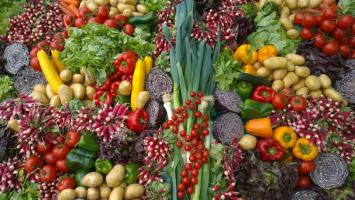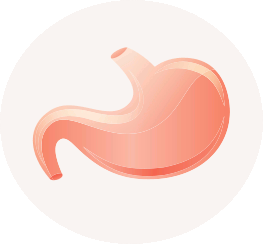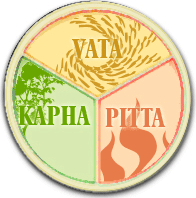STOMACH HEALTH REMEDIES

|
The stomach is called Amashaya in Ayurveda.  Categories in DigestionAppetiteStomachSmall IntestineColonAnal RegionMouthTeethPancreasAbdominal Pain LocationAbdominal Pain TypeAlarm SymptomsOverviewStop Indigestion: How to Strengthen the StomachAyurveda believes that imbalance begins in the digestive tract. The stomach is the focal point of this digestive belief. Ayurveda believes it is essential to address imbalances here to prevent more complicated disease manifestations. The stomach is the first place food goes after we eat it. So, the stomach responds quickly to the food, drinks and herbs you ingest, giving you an tremendous opportunity to influence your stomach health, and your health overall. Your stomach is strongly affected by diet. The food that you eat can:
Blood conditions also have a huge effect on your stomach, as blood rushes to your stomach every time you eat.
As a comprehensive, holistic form of medicine, Ayurveda excels in managing your diet and improving the strength of your blood, so you digest foods quickly and easily in your stomach. General Info - How does the stomach work?The stomach is a hollow, rounded organ in the gastrointestinal tract between the esophagus and duodenum. The inner layer is full of folds called rugae which allow it to stretch & hold onto food. The stomach comfortably stretches to one to two liters and maxes out at three to four liters when you overeat. Consistent gorging can permanently stretch out your stomach, diminishing optimal function.The stomach consists of four parts.
Stress & the StomachYour mental and emotional state while eating also influence stomach health. Stress is a common culprit in stomach disorders. Whether it be due to anger, anxiety, worry, sadness or overwhelm, stress reduces blood flow to the stomach, creates tension that hampers stomach movement, and can lead to ulcers and acid reflux. Do your best to calm down before sitting down to eat. And, relax 15 minutes after eating.Food churns in the stomach for about one to two hours. Contractions of the stomach (due to samana vayu) churn the food, mix it with the gastric juices and ensure it moves in the right direction, similar to the bubbling and movement within the pot of rice as it cooks. Stress, overeating, and undereating can disturb stomach movement, leading to indigestion. Hydration & the StomachDuring its incubation, the stomach releases about 2/3 of a liter of acid to process your meal. That acid is comprised of liquids retrieved from the blood. This is why hydration improves digestion by up to 25%!In order to digest food, the stomach tends to be a fiery organ. The fiery, hot acids and enzymes (Pachaka Pitta) in the stomach start the first phase of digestion. Ayurveda compares this process to "cooking" the food, similar to the fire under the pot of rice. Your stomach fire (agni) may be hampered by drinking too much fluid with your meal which hampers enzymes. If you drink too much water during a meal, you may feel slightly nauseated, or your stomach heavy and waterlogged. On the other hand, if you drink too little fluids in the hours before your meal, you may be dehydrated, which reduces enzyme production. Thus, your stomach fire can be hampered by too much or too little fluids. Mucus in the StomachThe stomach protects itself from fiery acids with a mucus barrier (Kledaka Kapha). Without this protective mucus barrier, your stomach would auto-digest itself. Kledaka Kapha also provides the liquid for food to "cook" evenly in the stomach, similar to the function of water when cooking rice. An excessively rich meal will thicken mucus in your stomach, making your digestion and your whole body feel heavy and sluggish. Alternatively, if your diet is too light, the mucus barrier will become too thin, which can lead to ulcers.General care for the stomachBe sure you are hydrated before you eat. Digestion in stomach requires a lot of juice - gastric juices, hydrochloric acids and the like. The stomach can't release these juices if you are dehydrated.Eat only when you are truly hungry. Digestion takes a lot of energy. Hunger is a signal that your body is in need of and ready to digest food. Eating when you are not hungry puts unnecessary strain on the body, inhibiting its ability to perform other important tasks such as cleansing or rejuvenation of tissue. Eating without hunger on a regular basis can weaken your digestion over the long term. Chew your food well. Digestion begins in the mouth. Your saliva contains digestive enzymes. Therefore, the more you chew your food, the more you help your body digest it! Also, breaking up large chunks of food mechanically in the mouth makes it easier for your stomach to complete the job of chemical digestion. Compare how much longer it takes stomach acids to break down a whole almond to how quickly your teeth can pulverize it. Eat only until you are two-thirds full. Stuffing yourself to maximum capacity leads to difficult digestion because your stomach can't contract to mix your food. Leaving some space in your stomach not only ensures optimal digestion, but keeps your mind clear and sharp and ensures a healthy appetite for the next meal. You will easily know when it's time to eat again. What you do after eating also affects your stomach health. As mentioned earlier, digestion takes a lot of energy. Relax after you eat to conserve energy. Thinking or exercising after eating uses up to much blood, blood needed for good digestion. Excessive activity like exercising after eating can easily induce nausea and indigestion. The first fifteen minutes after eating is a critical time to relax. Afterwards, go for a short walk to help your stomach churn the food. Then, return to work or daily activities. Allow for some down time. Rest your digestion between meal by minimizing snacking. Digestion takes a lot of energy and is a slow and careful process. It's ideal to allow at least 3 hours - optimally more like 5-6 hours - between meals so that stomach has time to digest and slowly release food to small intestine. Disorders of the StomachAmong the most common disorders of the stomach is feeling tired after eating. If your stomach is functioning optimally, you should feel light and energized post meal. If instead you feel like a brick is sitting in your belly, your stomach needs support. Folks who frequently experience slow, heavy digestion often complain of fatigue as well. Food seems to take forever to creep through the digestive tract and result in a bowel movement.Burping - especially when accompanied by the flavor of food you ate and a sense of heaviness in the stomach - is another common stomach disorder. While some burping is normal after a meal, an excess of burping points to fermentation of food and toxins (ama) in the stomach. Soreness and burning in the stomach can be a result of general inflammation, H. pylori infection, ulcers, bile or acid reflux and/or gastritis. These conditions of excess heat can make the stomach feel tender upon palpation and extremely sensitive to spicy food. Frequent nausea and indigestion also indicate stomach issues and are sometimes accompanied by vomiting. Stomach Disorders in Deficient Constitutions (Vata)Each body type is prone to certain types of stomach disorders based on the qualities associated with that dosha. As Vata is dry, Vata individuals typically have dry stomachs. They need to be especially aware of whether they are sufficiently hydrated when they sit down to eat. The mouth and tongue should be moist and saliva plentiful before your first bite. A dry mouth indicates a dry stomach. Without sufficient gastric juices, food will stagnate in the stomach leading to fermentation, bloating and/or acid reflux.Vata individuals also tend to have cold digestion, either due to poor circulation, stress, or anemia. Spices and herbs such as hingvastak churna can warm up Vata digestion. Take 1/4tsp hingvastak churna in a cup of heat tea a half hour before meals. The additional fluids will combat Vata dryness as well. Vata individuals should be sure their palate is moist when they sit down to eat. Alternatively, Vata folks may also drink fresh ginger, lime and salt thirty minutes before mealtime to increase bodily secretions, boost appetite and fire up digestion. Vata individuals should add spices to their meals such as ginger, black pepper, garlic, onion and turmeric. This helps their digestive fire to burn stronger and prevents stagnation of food in the stomach. Stomach Disorders in Fiery Constitutions (Pitta)For Pitta, the stomach tends to be hot, acidic and easily irritated. Pitta individuals are prone to burning sensations and inflammation. This irritation may cause a sensation of "false hunger" giving them a strong urge to eat. Their overproduction of stomach acid quickly digests their food, while a strong metabolism quickly burns up energy. Therefore, Pitta individuals get hungry quickly. They may become ravenous and "hangry" when food isn't ready on time. Their weak liver can also result in increased chemical sensitivity. Certain foods and smells make Pitta individuals frequently nauseas.Pitta individuals should favor cooling, soothing foods such as milk, oatmeal, and cucumber. They should avoid acidic and spicy foods like vinegar and cayenne pepper. Avipattikar churna sprinkled on top of food or taken in hot water thirty minutes before meals can improve digestion for Pitta individuals. Avipattikar churna won't irritate the stomach when it is inflamed. Alternatively, cooling, Pitta pacifying digestives such as cilantro, ginger, cardamom and fennel optimize Pitta type digestion. Stomach Disorders in Congested / Sluggish Constitutions (Kapha)Kapha individuals tend to have mucus laden, sluggish stomachs which easily tend toward stagnation. Overeating, overhydration, too much dairy or wheat and/or eating too late at night are common causes of Kapha stomach issues. These transgressions can lead to disorders involving acid reflux, feeling tired after eating, sluggish digestion, burping, nausea and/or vomiting.Kapha individuals should avoid soggy, gooey, heavy and demulcent foods such as wheat, dairy, oatmeal and okra as these types of foods can bog down their stomach creating stagnation and excess mucus. Kapha individuals do best when they eat a light and early dinner and avoid eating after dark. This ensures that food is out of the stomach by the time you lay down to go to bed and allows the stomach a long fasting period which ultimately strengthens the digestive fire. Kaphas can use generous amounts of spice in their cooking. Their stomachs tend to be slow and sluggish. Spices of any kind help perk it up. Pungent spices like black pepper and ginger heat up the stomach, while aromatic spices like oregano and thyme encourage the muscles to relax so that food can flow out of the stomach smoothly. Some of our favorite herb blends for supporting Kapha in the stomach are Trikatu, Mint Belly Bliss and Digestive Bitters. ConclusionProper care of the stomach ensures that digestion starts off right. Your stomach's performance sets the tone for the rest of digestion. Use these insights to identify the root causes of any stomach woes you experience and optimize your stomach function to feel your best.Don't know your body type? Take our free Dosha quiz!
TAKE THE QUIZ
4 likes  SAVE SYMPTOM SAVE SYMPTOMThe pyloric valve may leak when the stomach is overstuffed, when damaged, or when there is poor coordination. 3 likes  SAVE SYMPTOM SAVE SYMPTOMThick mucus in the stomach blocks the action of digestive enzymes, making digestion sluggish. In Ayurveda, mucus in the stomach is called an accumulation of Kledaka Kapha - one of the 5 canonical signs of Kapha dosha aggravation. Mucus in the... 55 likes  SAVE SYMPTOM SAVE SYMPTOMIndigestion is often the first warning sign of imbalance. The diet should be modified to avoid foods that are difficult to digest and that cause digestive upset. See 57 likes  SAVE SYMPTOM SAVE SYMPTOMDo You Have the Sluggish Digestion Blues? Friends don't let friends eat Twinkies(tm). My neighbor's kids, astounded by my 15 year Twinkie fast, somehow convinced me to eat one. Against my better Ayurvedic judgment, I indulged in this former... 82 likes  SAVE SYMPTOM SAVE SYMPTOMYou return to work after a tasty lunch. A new project sits on your desk. Rather than feeling ready to tackle it, you feel ready to take a nap. You feel tired after filling your belly, and have zero umph or inspiration. With a cloudy head and lunch in... 69 likes  SAVE SYMPTOM SAVE SYMPTOMIntroduction Everyone burps from time to time. Despite it being somewhat embarrassing, most people don't give burping a second thought. Have you ever stopped to think what your burps might be trying to tell you? Ayurveda has.... 20 likes  SAVE SYMPTOM SAVE SYMPTOMBlood has a metallic taste. Bleeding gums, gastrointestinal bleeding and acid reflux may cause a metallic taste.      (5.00 out of 5 stars) 7 ratings, 288 likes (5.00 out of 5 stars) 7 ratings, 288 likes SAVE SYMPTOM SAVE SYMPTOMIf heavy foods like cheeseburgers, burritos and ice cream trigger acid reflux, your stomach acid is probably too weak. Most acid reflux is triggered by... 33 likes  SAVE SYMPTOM SAVE SYMPTOMMost people who have acid reflux have hypoacidity, or too little acid. Only a stomach acid test can confirm if you have too much or too little acid. Hyperacidity can result from stress, high Kapha, or high Pitta. Hyperacidity may result from bile or...      (4.00 out of 5 stars) 2 ratings, 31 likes (4.00 out of 5 stars) 2 ratings, 31 likes SAVE SYMPTOM SAVE SYMPTOMHiatal hernia is a common cause of acid reflux. Development The lower esophageal sphincter (aka LES, also called the cardiac valve) is a one way valve that lets food into the stomach. Under the conditions or hernia, it may not... 35 likes  SAVE SYMPTOM SAVE SYMPTOMSores inside the mouth are often a sign of inflammation throughout the GI tract. Acidic foods like tomato or vinegar, irritating foods like coffee or chilis may aggravate intestinal mucosa, or flareups of intestinal bacteria may cause inflammation. 57 likes  SAVE SYMPTOM SAVE SYMPTOMAre You So Hungry It Hurts? You Might Have Gastritis. Hunger doesn't always come from a big appetite. Sometimes, it's a side-effect of inflammation. I once had a client that was 100 lbs overweight because she was always... 35 likes  SAVE SYMPTOM SAVE SYMPTOMAn ulcer is an open wound or sore on the lining of the GI tract. If you have a stomach ulcer, you may experience a gnawing or scraping sensation in your upper abdomen, usually in the top center or slightly to the left. This article will help you... 41 likes  SAVE SYMPTOM SAVE SYMPTOMNobody likes vomit. Especially other people's vomit. I remember the night my little sister vomited on me while I was sleeping. When my eyes came into focus, I found my sister had not only vomited, she had also passed out. Waking up in a puddle of vomit... 20 likes  SAVE SYMPTOM SAVE SYMPTOMVomiting is the forceful expulsion of stomach contents through the mouth. Often, contents of the duodenum, the first part of the small intestine, are also discharged. Vomiting is caused by irritants and harmful agents, such as viruses, bacteria, strong... 
AYURVEDIC FACE ASSESSMENT
Learn how to assess constitution by a person's face.
|
Join Joyful Belly.
Want our top Ayurvedic recipes and health tips?Subscribe to our free newsletter!














